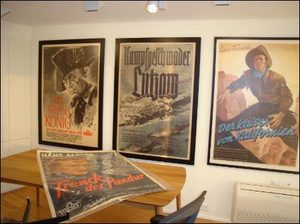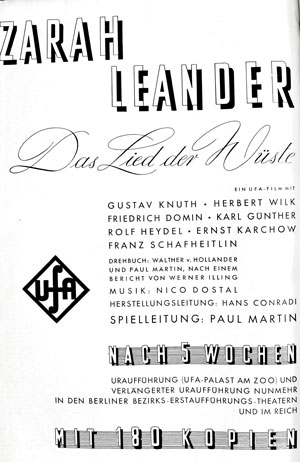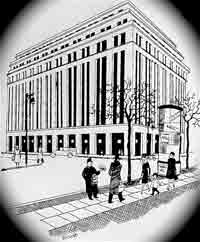Film Posters
 It is not certain how many copies of each film poster design were printed in preparation for distribution across the Reich. After the incorporation of former Austria into the Third Reich, the number of cinemas across "Grossdeutschland" numbered 6673 in 1939 (Walter,ibid, pg.42). The number of film posters printed would naturally correspond to the number of cinemas planned to screen a motion picture, from the "Premiere" picture palaces to the smallest village cinema. The posters were used again and again, on loan to the movie theatres.
It is not certain how many copies of each film poster design were printed in preparation for distribution across the Reich. After the incorporation of former Austria into the Third Reich, the number of cinemas across "Grossdeutschland" numbered 6673 in 1939 (Walter,ibid, pg.42). The number of film posters printed would naturally correspond to the number of cinemas planned to screen a motion picture, from the "Premiere" picture palaces to the smallest village cinema. The posters were used again and again, on loan to the movie theatres.
The Afifa film laboratory duplicated all feature film prints. The film ad from DER FILM newspaper below (1939) for a Zarah Leander film boasts that due to the film's success that Ufa film studio has "180 film prints" in circulation. Many less popular films had fewer prints in circulation at  any one time.
any one time.
In the biography about film man Oskar Kalbus, it is stated that in 1943/44 the German Film Distribution Company (DFV) had for rental 742 available feature films represented by some 40,500 film prints. That is an average of only 54 prints each title, making the 180 prints of the Leander film above a very popular box-office draw card. Correspondingly, such a low number of circulating film prints for many titles would translate into only a few hundred posters being printed for each of many of those titles.
Even the biggest box office hits could only appear in the top "first–run" cinemas nationally in the same weeks, at best. This allowed posters to be used and re-used as film screenings filtered down the cinema distribution chain from major cities to smaller locales. Posters were re-cycled and used again and again. The lithographic process made re–printing a new run of posters very uneconomical and burdensome.
The Handbuch für den Bogenanschlag (Jacques Albachary GmbH, Berlin) 1934 advertising book stated that stone lithography (Steindruck) was recommended only for poster print-runs of under 3,000 copies, and anything larger would require Offset printing. The Berlin poster expert and former owner of the "Filmantiquariat" on Pestalozzistraße in Schöneberg, Peter Böhnig, spoke with former Ufa film studio employees over the decades about posters in the 1930s and '40s and they said that the stone litho process wore the plates down so the largest "A0" sized posters were limited to just 60-80 copies altogether. The cinemas could not buy, but only hire the posters, which had penalties if the posters not returned at the end of a movie's run. It was even forbidden by wartime paper–shortage regulations for a cinema to display more than one poster of a movie at any time. It is no wonder that original copies of the Third Reich film posters in our Collection are exceedingly rare in any condition. Quite a few of ours are in good to very fine condition.

RIGHT: August Scherl publishers, Berlin, located at the corner of then Zimmer & Koch Strassen, printed many film posters prior to 1945.
An area of propaganda film production was that of the Reichspropagandaleitung, Hauptamt Film (National Propaganda Leadership Office, Film Central Office) and directly overseen by Dr. Goebbels and the NSDAP Reichsamtleiter Carl Neumann. In the book Der Film in Staat und Partei by Carl Belling (Berlin 1936, Verlag "Der Film") the RPL's output for 1935 was shown in the following chart.
 Some 141 films were produced and 148,000 pieces of printed material, film programs, and posters were printed. Even if one allows that only two–thirds of the printed matter was not posters, that would leave about 340 copies per each poster of each of the 141 films. Of course this does not take into account whether some films were more popular or more heavily promoted than others, or whether in fact there were even ten thousand posters printed in the year. But the number of poster copies per film title must have been very few.
Some 141 films were produced and 148,000 pieces of printed material, film programs, and posters were printed. Even if one allows that only two–thirds of the printed matter was not posters, that would leave about 340 copies per each poster of each of the 141 films. Of course this does not take into account whether some films were more popular or more heavily promoted than others, or whether in fact there were even ten thousand posters printed in the year. But the number of poster copies per film title must have been very few.
These authoritative comments confirm the conventional wisdom that the print-run of a film's poster was extremely limited per design "Muster," and why many of the posters in the Collection here can never be replaced.
The vast majority of the original German film posters held by the Gillespie Collection are lithographic posters from limited print-runs, or "Tiefdruck" 3-colour posters printed from a copper plate. Very few are Offset printed posters. Indeed, some of the posters in this Collection are not known to exist in German archives at all. DIE DEGENHARDTS is one example. Many other posters are very rare - according to poster gallery expert Dieter Hoffmann in Münich, for another example, there are only four known extant original copies of the famous 1943 Ufa MÜNCHHAUSEN poster in Germany, which can also be found in this Collection.
As most posters were returned to the film studios after use, and surviving copies then had to remain intact through the war, the post-war destruction of Nazi propaganda, and the ensuing six decades of major changes across Germany and Europe, it is no wonder that preserved, complete and undamaged original posters from this era are very rare, expensive, and basically "museum pieces" today.
 It is not certain how many copies of each film poster design were printed in preparation for distribution across the Reich. After the incorporation of former Austria into the Third Reich, the number of cinemas across "Grossdeutschland" numbered 6673 in 1939 (Walter,ibid, pg.42). The number of film posters printed would naturally correspond to the number of cinemas planned to screen a motion picture, from the "Premiere" picture palaces to the smallest village cinema. The posters were used again and again, on loan to the movie theatres.
It is not certain how many copies of each film poster design were printed in preparation for distribution across the Reich. After the incorporation of former Austria into the Third Reich, the number of cinemas across "Grossdeutschland" numbered 6673 in 1939 (Walter,ibid, pg.42). The number of film posters printed would naturally correspond to the number of cinemas planned to screen a motion picture, from the "Premiere" picture palaces to the smallest village cinema. The posters were used again and again, on loan to the movie theatres. any one time.
any one time.
 Some 141 films were produced and 148,000 pieces of printed material, film programs, and posters were printed. Even if one allows that only two–thirds of the printed matter was not posters, that would leave about 340 copies per each poster of each of the 141 films. Of course this does not take into account whether some films were more popular or more heavily promoted than others, or whether in fact there were even ten thousand posters printed in the year. But the number of poster copies per film title must have been very few.
Some 141 films were produced and 148,000 pieces of printed material, film programs, and posters were printed. Even if one allows that only two–thirds of the printed matter was not posters, that would leave about 340 copies per each poster of each of the 141 films. Of course this does not take into account whether some films were more popular or more heavily promoted than others, or whether in fact there were even ten thousand posters printed in the year. But the number of poster copies per film title must have been very few.